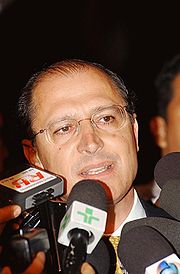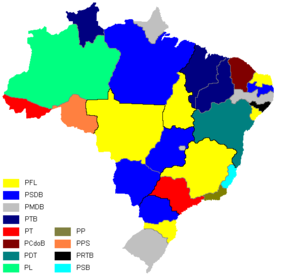Elections in Brazil 2006
The 2006 elections in Brazil included multiple rounds of executive and legislative elections at the national and state levels in Brazil .
The elections took place on October 1st and October 29th. The second date was for the necessary runoff elections for offices of the president and governor who did not achieve an absolute majority of the votes in the first ballot. In the 2006 elections, the following were up for grabs:
- President and Vice President
- Members of the National Congress : all 513 members of the Câmara dos Deputados and one third of the 81 Senators (Senado Federal)
- Governors and Vice-Governors of all 26 states and the federal district.
Historical context
The 2006 elections come at a time of upheaval in Brazilian politics.
In the 2002 elections, the PT ( Partido dos Trabalhadores ) became the strongest party for the first time (with 18%) and, with Luís Inácio Lula da Silva, was the president. The PSDB ( Partido da Social Democracia Brasileira ) and Fernando Henrique Cardoso , who was not allowed to run again (only two terms are allowed), were replaced. In 2002 fears were fueled that with Lula the economy would suffer badly and that the political situation would become unstable. Lula with a very broad coalition government, however, continued Cardoso's policy in a more or less social-democratic to neoliberal manner. The socio-economic situation has improved, but on the other hand he has only partially fulfilled the expectations of his supporters. Adding to this dissatisfaction were allegations of corruption portraying the PT as a "normal" Brazilian party, in this case one that betrayed its ideals.
Verticalization was introduced for the 2002 elections . It enforces that political alliances of several parties at the state level cannot differ from the alliances at the federal level. Since the many Brazilian parties are inherently very heterogeneous (they are often referred to as electoral associations ), the aim is to guarantee a certain ideological consistency. Critics of this rule point out that situations can vary widely between states and federal states. On March 8th, the verticalization was abolished by the Congress, but this is only allowed to take effect a year later, so the new rules do not apply until 2010. Small parties without a presidential candidate can form a coalition as the Supreme Electoral Council ( Tribunal Superior Eleitoral ) determined .
President and Vice President
In the first ballot none of the candidates was elected with an absolute majority. So Lula and Alckmin had to go to the second ballot on October 29th. In the second round Lula was able to win clearly, with about the same percentage of votes as 4 years earlier. As in the first round, he won in the north and north-east by a large margin (Amazonas 87%, Maranhão 85%, Ceará 82%, in his native state Pernambuco 78%). In the south, on the other hand, he lost (45% in the former PT stronghold Rio Grande do Sul, Santa Catarina 45%, São Paulo 48%), and he received the fewest votes in Roraima (39%).
| Candidate - party (1st ballot) | Number of votes in 2006 | Percent of voters in 2006 | Percent of eligible voters in 2006 |
|---|---|---|---|
| Lula - PT | 46,662,365 | 48.61 | 37.06 |
| Geraldo Alckmin - PSDB | 39,968,369 | 41.64 | 31.74 |
| Heloísa Helena - PSOL | 6,575,393 | 6.85 | 5.22 |
| Cristovam Buarque - PDT | 2,538,844 | 2.64 | 2.02 |
| Ana Maria Rangel - PRP | 126,404 | 0.13 | 0.10 |
| José Maria Eymael - PSDC | 63.294 | 0.07 | 0.05 |
| Luciano Bivar - PSL | 62,064 | 0.06 | 0.05 |
| White ballot papers | 2,866,205 | 2.28 | |
| Invalid ballot | 5,957,207 | 4.73 | |
| Non-voters | 21.092.511 | 16.75 |
| Candidate - party (runoff) | Number of votes in 2006 | Percent of voters in 2006 | Percent of eligible voters in 2006 |
|---|---|---|---|
| Lula - PT | 58.295.042 | 60.83 | 46.30 |
| Geraldo Alckmin - PSDB | 37,543,178 | 39.17 | 29.82 |
| White ballot papers | 1,351,448 | 1.07 | |
| Invalid ballot | 4,808,553 | 3.82 | |
| Non-voters | 30,074,715 | 18.99 |
The candidates for the presidential election in detail:
The candidate is the incumbent President Luiz Inácio Lula da Silva . The Partido Republicano Brasileiro (PRB) of Vice José Alencar (as in 2002) and the Partido Comunista do Brasil (PC do B) form a coalition with the PT that is informally formed by the Partido Liberal (PL) and the Partido Socialista Brasileiro (PSB ) and is supported by parts of the Partido do Movimento Democrático Brasileiro (PMDB) and the Partido Trabalhista Brasileiro (PTB).
Geraldo Alckmin was governor of São Paulo , for the candidacy he had to give up this office. He is the most promising candidate after Lula. He is also supported by the Partido da Frente Liberal (PFL), which is Vice-President José Jorge . The candidacy is also informally supported by the Partido Popular Socialista (PPS).
Senator Heloísa Helena , like her Vice César Benjamin, was a prominent member of the PT until she was expelled because of clear criticism of the government's course. The PSOL then became the reservoir for dissatisfied PT people. Together with the Partido Socialista dos Trabalhadores Unificado (PSTU) and the Partido Comunista Brasileiro (PCB) it forms a coalition called the Frente de Esquerda (“Left Front”).
The PDT appointed Senator Cristovam Buarque from Brasília , who left the PT in 2005. Senator Jefferson Péres from Amazon is running as vice- president
The candidate is Ana Maria Rangel .
She set up José Maria Eymael and José Paulo Neto .
- Partido Social Liberal (PSL)
A small party with entrepreneurs Luciano Bivar and Américo de Souza .
- The Partido Verde (PV) has turned its back on the government, but has not nominated and does not support any candidate for the presidency.
- The Partido da Reedificação da Ordem Nacional (PRONA) has already nominated Enéas Carneiro three times as a candidate, but this time he is not running for health reasons.
The last forecasts at the end of September indicate a victory for Lula (Lula ~ 50%, Alckmin ~ 30%, Heloisa Helena ~ 10%)
Câmara dos Deputados (House of Representatives)
Of the 5514 candidates, 513 were elected. In Brazil there is a certain number of MPs in each state according to the number of inhabitants, but small states are "preferred" by a minimum number of MPs. The PT got the most votes nationwide, but not the most MPs. The number of seats of a party per state is proportional to the number of votes that are cast for a party. There is no minimum quota.
Most voters in Brazil do not vote for a party, they vote for people who always appear on party lists. The votes of all candidates in a party plus the votes for the list result in the total number of votes, which is used to determine the number of seats. The candidates who received the most votes then move into the House of Representatives. So there are neither constituencies nor state lists.
The number of seats at the end of a legislative period can often change as many MPs change parties. At the time of the 2006 election, the PT only had 81 of the original 91 MPs left in 2002.
senate
There are 3 senators from each state in the Senate. The term of office is 8 years. This time only one new senator will be elected, in 2010 two at a time.
- Acre - Tião Viana (PT) with 88.8% of the vote
- Alagoas - Fernando Collor de Mello (PRTB) Former president removed for corruption
- Amazonas (Brazil) - Alfredo Nascimento (PL)
- Amapá - José Sarney (PMDB) former president
- Bahia - João Durval (PDT)
- Ceará - Inácio Arruda (PC do B) with 52.3%
- Distrito Federal do Brasil - Joaquim Roriz (PMDB)
- Espírito Santo - José Renato Casagrande (PSB) with 62.4%
- Goiás - Marconi Perillo (PSDB) with 75.8%
- Maranhão - Epitácio Cafeteira (PTB)
- Mato Grosso - Jayme Campos (PFL)
- Mato Grosso do Sul - Marisa Serrano (PSDB)
- Minas Gerais - Eliseu Resende (PFL)
- Pará - Mário Couto (PSDB)
- Paraíba - Cícero Lucena (PSDB)
- Paraná - Álvaro Dias (PSDB)
- Pernambuco - Jarbas Vasconcelos (PMDB)
- Piauí - João Vicente Claudino (PTB) with 65.4%
- Rio de Janeiro (State) - Francisco Dornelles (PP)
- Rio Grande do Norte - Rosalba Ciarlini (PFL)
- Rio Grande do Sul - Pedro Simon (PMDB) with 33.9%
- Rondônia - Expedito Júnior (PPS)
- Roraima - Mozarildo (PTB)
- São Paulo (state) - Eduardo Suplicy (PT) with 47.8%
- Santa Catarina - Raimundo Colombo (PFL)
- Sergipe - Maria do Carmo (PFL)
- Tocantins - Kátia Abreu (PFL)
Governors
The elections are based on the same principles as the presidential election.
In the first ballot, the following were elected with an absolute majority of the votes:
- Acre - Binho Marques (PT) 53.5%
- Alagoas - Teotônio Vilela Filho (PSDB) 55.9%
- Amapá - Waldez Góes (PDT) 53.7%
- Amazon - Eduardo Braga (PMDB) 50.6%
- Bahia - Jaques Wagner (PT) 52.9%
- Ceará - Cid Gomes (PSB) 62.4%
- Distrito Federal - José Roberto Arruda (PFL) 50.4%
- Espírito Santo - Paulo Hartung (PMDB) 77.3%
- Mato Grosso - Blairo Maggi (PPS) 65.4%
- Mato Grosso do Sul - André Puccinelli (PMDB) 61.3%
- Minas Gerais - Aécio Neves (PSDB) 77.0%
- Piauí - Wellington Slides (PT) 61.9%
- Rondônia - Ivo Cassol (PPS) 54.1%
- Roraima - Ottomar Pinto (PSDB) 62.4%
- São Paulo - José Serra (PSDB) 57.9%
- Sergipe - Marcelo Déda (PT) 52.5%
- Tocantins - Marcelo Miranda (PMDB) 51.5%
In the second ballot, the decision was made between (the first-named won the election):
- Goiás - Alcides Rodrigues (PP) (57.1%) vs. Maguito Vilela (PMDB)
- Maranhão - Jackson Lago (PDT) (51.8%) vs. Roseana Sarney (PFL)
- Pará - Ana Júlia Carepa (PT) (54.9%) vs. Almir Gabriel (PSDB)
- Paraíba - Cássio Cunha Lima (PSDB) (51.3%) vs. José Maranhão (PMDB)
- Paraná - Roberto Requião (PMDB) (50.1%) vs. Osmar Dias (PDT)
- Pernambuco - Eduardo Campos (PSB) (65.4%) vs. Mendonça Filho (PFL)
- Rio de Janeiro - Sérgio Cabral (PMDB) (68.0%) vs. Denise Frossard (PPS)
- Rio Grande do Sul - Yeda Crusius (PSDB) (53.9%) vs. Olívio Dutra (PT)
- Rio Grande do Norte - Wilma Faria (PSB) (52.4%) vs. Garibaldi Alves Filho (PMDB)
- Santa Catarina - Luiz Henrique da Silveira (PMDB) (52.7%) vs. Espiridião Amin (PP)
Member of State Parliaments
In the 2006 election, 12,817 national candidates stood for election as members of the respective Assembleia Legislativa.
Web links
- Tribunal Superior Eleitoral : Resultado da eleição 2006 , database of the Supreme Electoral Court




